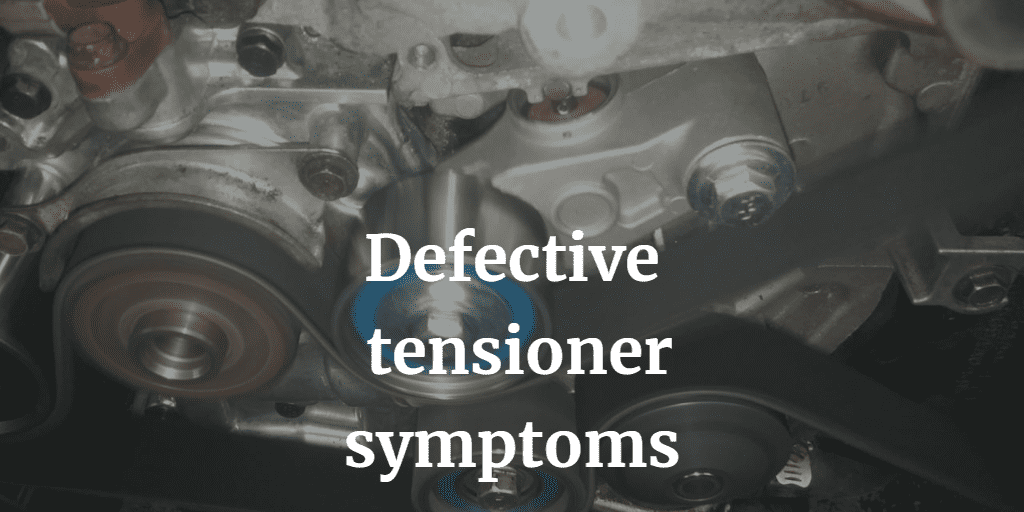Belt tensioners are pulleys positioned on a spring system or customizable pivot point that maintains belt tension. Spring tensioners are built to exert even pressure on the pivot, while adjustment pivot styles may need to be adjusted manually. They are both employed to hold the serpentine engine belts in place to operate the different engine accessories.
Tensioner failure can negatively influence belt driving mechanisms, which can damage the vehicle’s performance and overall operation. A malfunctioning tensioner will often generate several symptoms, and this might serve as a warning that the car should be serviced. Such cases are noticeable in the 2003 Ford Taurus car model, by noises coming from the belt.
Symptoms of Ford belt tensioner failure

- The belt or tensioner produces a grinding or squeaking sound
Often, a belt tensioner failure will result in belts and tensioner noises. A loose tensioner, which would likely cause belts to squeak on starting the engine, is most likely the issue. A bearing or pulley may wear out, causing the pulley to make a grinding noise.
- Unusual wearing of the belt
If you notice unusual belt wear, it could be an indicator of a potential problem. If there is a problem with the tensioner pulley, it might create abnormal and rapid wearing of the belt. Pulleys with poor connections can cause fraying at the belt’s edges, and in some situations, they can make the straps break.
- Malfunctioning of other accessories
Belt-driven attachments inevitably fail when the belt tensioner fails as well. Numerous engine accessories, including the alternator, cooling system, and AC system, are belt driven. A stuck or unsecured belt tensioner can result in belt snapping, hence disabling all of the attached components.
This results in problems such as overheating, a dead battery, or a defective AC system. Typically, a belt that collapsed due to the tensioner must be repaired to restore the vehicle’s performance.
How to check for a faulty 2003 ford Taurus belt tensioner

The belt can fail for various reasons, including its age or issues with the belt tensioner. A defective tensioner may trigger the belt and the pulley, thus removing the belt. If you suspect a problem with your drive belt tensioner, get the vehicle evaluated by a competent mechanic to determine whether it needs to be fixed.
1. The function of the belt tensioner

It is a rubberized belt that connects a system of gears and pulleys and runs through them. Due to old age and the high temperatures, the belt will loosen with time. Loose belts require tight tensioners to stay tight. There are two primary forms of belt tensioners;
i. The hydraulic tensioner
It constantly presses down on the belt with pressure to ensure it remains tight and sets the tensioner against the belt so that it may move. One may close the open tensioner though the engine oil pressure may be used instead.
ii. The manual tensioner
Typically, this works with a spring. The spring, which anchors the engine and the tensioner, is grounded by both the engine and the tensioner. The belt is kept taut as it stretches during the spring season.
2. Defective tensioner symptoms

Tensioners fail when they become faulty and can lead to many various symptoms.
i. When the tensioner or pulley malfunctions, the belt and the pulleys might generate chirping and rattling noises of high pitch due to a loss of tension. When a pulley bearing completely collapses, it could cause squealing or grinding noises.
ii. For the tensioner to work, the belt must be tight. If the belt is loose, it can cause damage to various components. This could result in a slap or a knock.
iii. Though the most typical indication of a faulty belt is a particular noise produced, it could cause an engine light. This could indicate that the control on one of the valves is incorrect.
3. Resolving Ford belt tensioner noise

The following techniques help resolve belt noise issues.
i. Twist the tensioner
Tighten the wrench around the tensioner until the whole arm can move in all directions. Notice the flowing motion while you also feel spring tension. A movement that sticks or does not move smoothly can suggest a spring or bearing issues.
Move the arm up and down, and in case of any lateral movement, it could mean that the bearing or spring is broken. Various shock-absorbing devices found in some tensioners help to moderate the vibrations. A worn dampener and low spring tension lead to excessive arm movements and chattering. Since tensioners are wearing parts, their life duration is limited.
ii. Check the positioning of the pulley
Several alignment tools will help you identify problems with alignment. You will have the comfort of knowing that there is an improperly positioned pulley, hence aligning it to the correct position.
iii. Spray the belt tensioner down
This method was previously used to show slipping belts or that noises from the belts disappeared on spraying. This test can be applied to separate worn pulley bearings since it eliminates belt noise, often belt-positioning issues. Water should be used solely as oiling the old belts will damage the newer EPDM belts, resulting in louder noises.
iv. Eliminate the belt
Remove the belt and start the engine if you face difficulties in getting rid of the belt noise. If the noise persists, there could be motor issues or problems with the timing belt. With the belt removed, you may inspect the pulleys and belt for any possible issues.
v. Check the belt groove
As the belt moves across the pulleys, the friction created makes the belt wear out. As the grooves in the pulleys wear out, the grooves also wear, resulting in the belt slipping.
Conclusion
A belt tensioner is a critical component since it ensures that the belt is properly tensioned and capable of driving the vehicle’s components. Designing a belt system is one of the most challenging tasks. The system is affected by numerous influences, each of which must be considered.
If correctly done, the belt will eventually be silent, efficient, and last a century. Alternatively, the belt could be loud or make the engine work less efficiently. If the belt does break, it can result in significant damage. Have your car evaluated by a skilled mechanic to assess if the belt tensioner should be changed.
This video will show you how to repair, install, fix, change or replace a broken, noisy, squeaky, worn or groaning serpentine belt tensioner.
